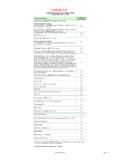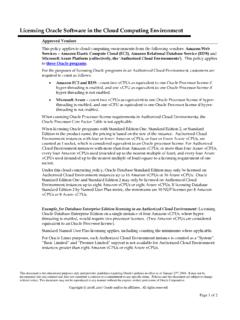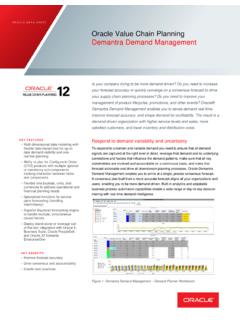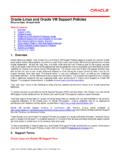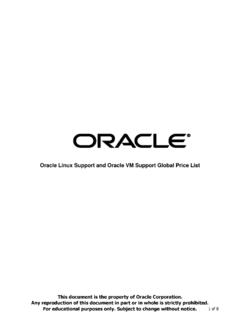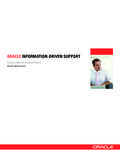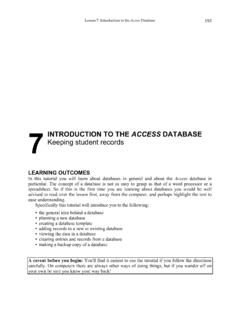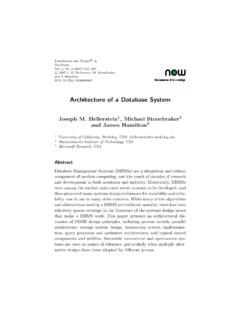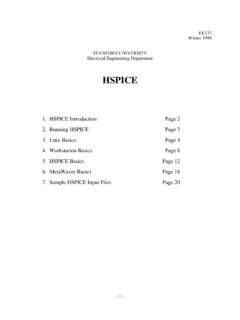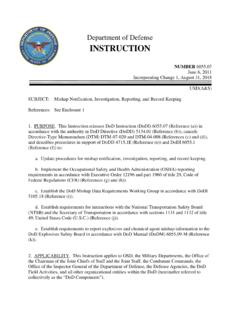Transcription of twp partitioning 19c 2019 02 - Oracle
1 Oracle partitioning Extreme Data Management and Performance WHITE PAPER / FEBRUARY 19, 2019 2 WHITE PAPER / Oracle partitioning PURPOSE STATEMENT This document provides an overview of features and enhancements of Oracle partitioning . It is intended solely to help you assess the business benefits of Oracle database and to plan your projects. DISCLAIMER This document in any form, software or printed matter, contains proprietary information that is the exclusive property of Oracle . Your access to and use of this confidential material is subject to the terms and conditions of your Oracle software license and service agreement, which has been executed and with which you agree to comply. This document and information contained herein may not be disclosed, copied, reproduced or distributed to anyone outside Oracle without prior written consent of Oracle .
2 This document is not part of your license agreement nor can it be incorporated into any contractual agreement with Oracle or its subsidiaries or affiliates. This document is for informational purposes only and is intended solely to assist you in planning for the implementation and upgrade of the product features described. It is not a commitment to deliver any material, code, or functionality, and should not be relied upon in making purchasing decisions. The development, release, and timing of any features or functionality described in this document remains at the sole discretion of Oracle . Due to the nature of the product architecture, it may not be possible to safely include all features described in this document without risking significant destabilization of the code.
3 3 WHITE PAPER / Oracle partitioning TABLE OF CONTENTS Purpose Statement .. 2 introduction .. 4 partitioning Fundamentals .. 5 Concept of partitioning .. 5 partitioning for Performance .. 7 partitioning for Manageability .. 8 partitioning for Availability .. 9 Information Lifecycle Management with partitioning .. 10 partitioning Strategies .. 11 Data distribution methods for partitioned objects .. 11 partitioning Extensions .. 12 Partition Advisor .. 14 partitioning Functionality at a Glance .. 15 Conclusion .. 17 4 WHITE PAPER / Oracle partitioning introduction With more than 20 years in development, Oracle partitioning has established itself as one of the most successful and commonly used functionalities of the Oracle database .
4 With Oracle partitioning , a single logical object in the database is subdivided into multiple smaller physical objects, so-called partitions. The knowledge about this physical partitioning enables the database to improve the performance, manageability, or availability for any application. Whether you have an OLTP, a data warehouse, or a mixed workload application and whether your system is hundreds of GBs or in the Petabyte range, you will benefit from partitioning . Queries and maintenance operations are sped up by an order of magnitude, while minimizing the resources necessary for processing. Together with zone maps pruning capabilities are unlimited: tables and partitions are broken down into smaller physical zones that are used for fine-grained data pruning, in addition to the knowledge of partitions in a table.
5 partitioning can greatly reduce the total cost of data ownership, using a tiered archiving approach of keeping older relevant information still online, in the most optimal compressed format and on low cost storage devices, while storing the hottest data in Oracle s in-memory column store. When used together with Automatic Data Optimization and Heat Maps, partitioning provides a simple and automated way to implement an Information Lifecycle Management (ILM) strategy. With hybrid partitioned tables, introduced in Oracle database 19c, partitioned tables now can also spawn internal and external storage within the same logical table, bringing ILM to the next level. Oracle partitioning improves the performance, manageability, and availability for tens of thousands of customers and hundreds of thousands of applications.
6 Everybody can benefit from it, and so can you. 5 WHITE PAPER / Oracle partitioning partitioning FUNDAMENTALS Concept of partitioning partitioning enables tables and indexes to be subdivided into individual smaller pieces. Each piece of the database object is called a partition. A partition has its own name, and may optionally have its own storage characteristics. From the perspective of a database administrator, a partitioned object has multiple pieces that can be managed either collectively or individually. This gives the administrator considerable flexibility in managing a partitioned object. However, from the perspective of the application, a partitioned table is identical to a non-partitioned table; no modifications are necessary when accessing a partitioned table using SQL DML commands.
7 Logically, it is still only one table and any application can access this one table as they do for a non-partitioned table. database objects tables and indexes - are partitioned using a partitioning key, a set of columns that determine in which partition a given row will reside. The partitions of a table physically store the data, while the table itself is metadata only. For example, the Sales table shown in Figure 1 is range-partitioned on sales (order) date, using a monthly partitioning strategy; the table appears to any application as a single, 'normal' table. However, the database administrator can manage and store each monthly partition individually, optimizing the data storage according to the importance of data and the frequency of being used.
8 Partitions storing older ranges of data can be stored in different storage tiers using table compression (or even stored in read only tablespaces or marked as read only partitions) while the newest partitions are marked for being stored in Oracle s in-memory column store. With hybrid partitioned tables, some partitions can reside on internal storage while others reside on external storage, all within the same logical table. In case of a composite partitioned table, a partition is further subdivided into subpartitions, using a second set of columns for further subdivision within a partition; the data placement of a given row is then determined by both partitioning key criteria and placed in the appropriate subpartition.
9 With a composite partitioned table, the partition level becomes a metadata layer. Only subpartitions are physically stored on disk1. In the case of a partitioned external table, the concept of having different physical segments for different parts of a table is extended to physical storage outside the database . Each partition of an external table has one or multiple individual files that represent the subset of data of the partition. However, unlike regular partitioned tables, the data placement is not enforced by the database . External tables, partitioned or non-partitioned, are read only. Hybrid partitioned tables combine the concept of both internal and external partitioned tables. As the name suggests, with such a partitioned table you can have both partitions being stored internal (in the database ) and external (on physical storage outside the database ).
10 The same rules apply for external partitions of a hybrid partitioned table than for partitions of a partitioned external table: the data placement is not enforced by the database , and the content of such partitions is read only. One logical object, many physical partitions From the perspective of the application you have one table you access. From the perspective of the administrator, you have multiple partitions you manage individually. Figure 1: Application and DBA view of a partitioned table 6 WHITE PAPER / Oracle partitioning Application developers generally do not have to worry about whether or not a table is partitioned, but they also can leverage partitioning to their advantage: for example, a resource intensive DML operation to purge data from a table can be implemented using partition maintenance operations, improving the runtime dramatically while reducing the resource consumption significantly.
